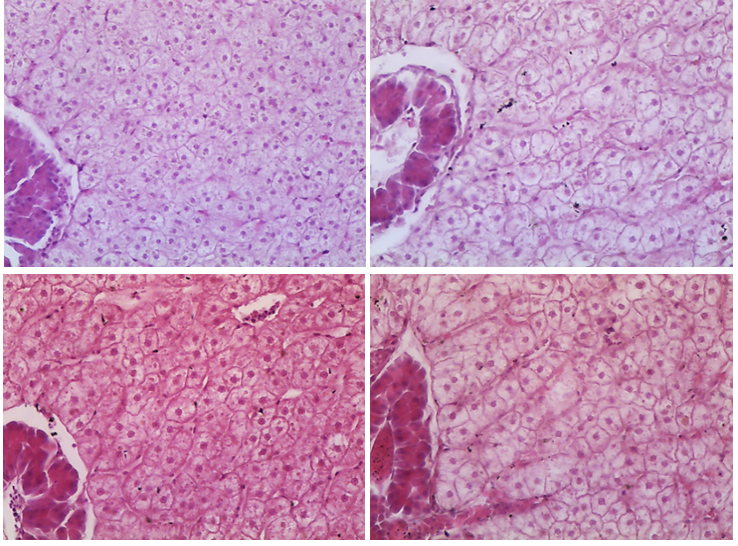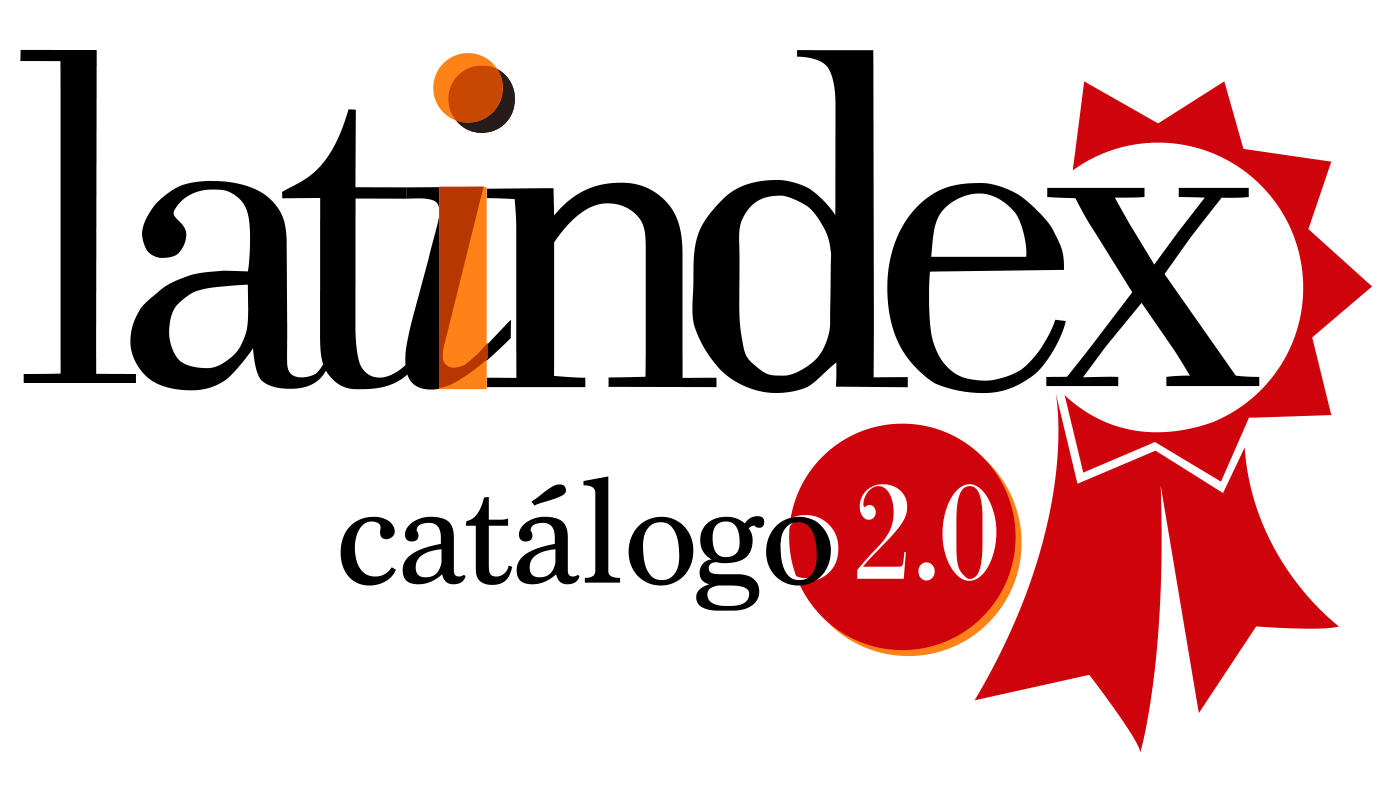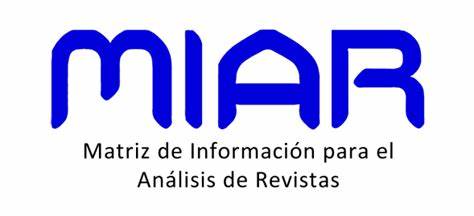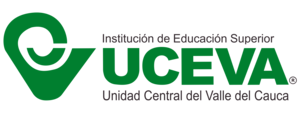Histopathological analysis of Colossoma macropomum liver, treated with bioproducts used by controlling parasites
DOI:
https://doi.org/10.54502/msuceva.v2n1a11Palabras clave:
Acanthocephala, Amazon fish, extract of garlic, Neoechinorhynchus buttnerae, organic acidsResumen
Possible histological changes in the liver of Colossoma macropomum Cuvier, 1816 (tambaqui) generated by the use of products incorporated into the diet as a control method of Neoechinorhynchus buttnerae Golvan, 1956 were evaluated. 1036 juveniles tambaqui with 77±3.0g of average weight were used, maintained in 28 polyethylene tanks of 1000L, with constant aeration and water recirculation system, using UV filter. The experimental units (30 fish per experimental unit) were distributed into four treatments, with seven replicates. The products, incorporated in fish oil, were added to the feed, according to the treatments: control group with commercial feed (Nutrizon Karino 36% GW) (A); extract of garlic (B); organic acids (C) and extract of garlic + organic acids (D). A parasitic and histopathological evaluation was performed at time zero (T0). During the experiment, two samples were collected, with an interval of five weeks, evaluating 15 fish per experimental unit. At the end, 63 liver samples for histological analysis were collected. The evaluated animals presented the expected growth for the species. 87.2% of efficacy was obtained with the association extract of garlic + organic acids. Hepatic morphological lesions compatible with toxicological processes were not observed, indicating a low toxicity for tested concentrations.
Descargas
Métricas
Citas
Valenti WC, Barros HP, Moraes-Valenti P, Bueno GW, Cavalli RO. Aquaculture in Brazil: past, present and future. Aquaculture Reports 2021;19:100611.https://doi.org/10.1016/j.aqrep.2021.100611 DOI: https://doi.org/10.1016/j.aqrep.2021.100611
Márquez I, García-Vázquez E, Borrell YJ. Possible effects of vaccination and environmental changes on the presence of disease in northern Spanish fish farms. Aquaculture 2014;431:118–23. https://doi.org/10.1016/j.aquaculture.2013.12.030 DOI: https://doi.org/10.1016/j.aquaculture.2013.12.030
Chang Y-J, Hsu J, Lai P-K, Lan K-W, Tsai W-P. Evaluation of the impacts of climate change on albacore distribution in the South Pacific Ocean by using ensemble forecast. Front Mar Sci 2021;8. https://doi.org/10.3389/fmars.2021.731950 DOI: https://doi.org/10.3389/fmars.2021.731950
Bashir I, Lone FA, Bhat RA, Mir SA, Dar ZA, Dar SA. Concerns and threats of contamination on aquatic ecosystems. Bioremediation and Biotechnology, Cham: Springer International Publishing; 2020, p. 1–26. https://doi.org/10.1007/978-3-030-35691-01
Valladão GMR, Gallani SU, Pilarski F. Phytotherapy as an alternative for treating fish disease. Journal of Veterinary Pharmacology and Therapeutics 2015;38:417–28. https://doi.org/10.1111/jvp.12202 DOI: https://doi.org/10.1111/jvp.12202
Goulding M, Venticinque E, Ribeiro ML de B, Barthem RB, Leite RG, Forsberg B, et al. Ecosystem-based management of Amazon fisheries and wetlands. Fish and Fisheries 2019;20:138–58. https://doi.org/10.1111/faf.12328 DOI: https://doi.org/10.1111/faf.12328
Tavares-Dias M, Martins ML. An overall estimation of losses caused by diseases in the Brazilian fish farms. Journal of Parasitic Diseases 2017;41:913–8. https://doi.org/10.1007/s12639-017-0938-y DOI: https://doi.org/10.1007/s12639-017-0938-y
Silva Gomes AL, Gomes Coelho Filho J, Viana Silva W, Braga Oliveira MI, Bernardino G, Ismael Costa J. The impact of Neoechinorhynchus buttnerae (Golvan, 1956) (Eoacanthocephala: Neochinorhynchidae) outbreaks on productive and economic performance of the tambaqui Colossoma macropomum (Cuvier, 1818), reared in ponds. Latin American Journal of Aquatic Research 2017;45:496–500. https://doi.org/10.3856/vol45-issue2-fulltext-25 DOI: https://doi.org/10.3856/vol45-issue2-fulltext-25
Bueno GW, Ostrensky A, Canzi C, de Matos FT, Roubach R. Implementation of aquaculture parks in Federal Government waters in Brazil. Reviews in Aquaculture 2015;7:1–12.https://doi.org/10.1111/raq.12045 DOI: https://doi.org/10.1111/raq.12045
Costa J, Freitas R, Gomes AL, Bernadino G, Carneiro D, Martins MI. Effect of stocking density on economic performance for Colossoma macropomum (Cuvier, 1816), juvenile in earthen ponds. Latin American Journal of Aquatic Research 2016;44:165–70. https://doi.org/10.3856/vol44-issue1-fulltext-18 DOI: https://doi.org/10.3856/vol44-issue1-fulltext-18
Chagas E, Maciel P, Jerônimo G, Tavares Dias M, Pereira S, Martins M, et al. Doença negligenciada afeta peixes cultivados na Amazônia brasileira. Panorama Da Aqüicultura 2016;26:22–9. https://panoramadaaquicultura.com.br/acantocefalose-doenca-negligenciada-afeta-peixes-cultivados-na-amazonia-brasileira/
Oliveira M, Vasconcelos V. Occurrence of mycotoxins in fish feed and its effects: A review. Toxins (Basel) 2020;12:160. https://doi.org/10.3390/toxins12030160 DOI: https://doi.org/10.3390/toxins12030160
Rajeshkumar S, Li X. Bioaccumulation of heavy metals in fish species from the Meiliang Bay, Taihu Lake, China. Toxicology Reports 2018;5:288–95. https://doi.org/10.1016/j.toxrep.2018.01.007 DOI: https://doi.org/10.1016/j.toxrep.2018.01.007
Galarza E, Cabrera M, Espinosa R, Espitia E, Moulatlet GM, Capparelli M. Assessing the quality of amazon aquatic ecosystems with multiple lines of evidence: the case of the Northeast Andean Foothills of Ecuador. Bulletin of Environmental Contamination and Toxicology 2021;107:52–61. https://doi.org/10.1007/s00128-020-03089-0 DOI: https://doi.org/10.1007/s00128-020-03089-0
Cabello FC, Godfrey HP, Tomova A, Ivanova L, Dölz H, Millanao A, et al. Antimicrobial use in aquaculture re-examined: its relevance to antimicrobial resistance and to animal and human health. Environmental Microbiology 2013;15:1917–42.
https://doi.org/10.1111/1462-2920.12134 DOI: https://doi.org/10.1111/1462-2920.12134
Nik Mohamad Nek Rahimi N, Natrah I, Loh J-Y, Ervin Ranzil FK, Gina M, Lim S-HE, et al. Phytocompounds as an alternative antimicrobial approach in aquaculture. Antibiotics 2022;11:469. https://doi.org/10.3390/antibiotics11040469 DOI: https://doi.org/10.3390/antibiotics11040469
Esch GW, Fernández JC. Factors influencing parasite populations. A functional biology of parasitism, Dordrecht: Springer Netherlands; 1993:49–90. https://doi.org/10.1007/978-94-011-2352-53
Martins M, Onaka E, Moraes F. Mebendazole treatment against Anacanthoras penilabiatus (Monogenea, Dactylogyridae) gill parasite of cultivated Piaractus mesopotamicus (Osteichthyes, Characidae) in Brazil. Efficacy and hematology. Acta Parasitologica Warsaw: Witold Stefanski Inst Parasitology 2001;46:332–6
Junqueira L, Carneiro J. Histología Básica. 12th ed. Ediciones Journal. Libros para profesionales de la salud ; 2015
Olusola S, Emikpe B, Olaifa F. The potentials of medicinal plant extracts as bio-antimicrobials in aquaculture. International Journal of Medicinal and Aromatic Plants 2013;3:404–12.
Reverter M, Bontemps N, Lecchini D, Banaigs B, Sasal P. Use of plant extracts in fish aquaculture as an alternative to chemotherapy: Current status and future perspectives. Aquaculture 2014;433:50–61. https://doi.org/10.1016/j.aquaculture.2014.05.048 DOI: https://doi.org/10.1016/j.aquaculture.2014.05.048
Ocampo C, Auró O. Terapia de las enfermedades de los peces. 2nd ed. México, D.F.: SUA Editorial, FMVZ-UNAM; 2000.
Ndong D, Fall J. The effect of garlic (Allium sativum) on growth and immune responses of hybrid tilapia (Oreochromis niloticus x Oreochromis aureus). The Effect of Garlic (Allium sativum) on Growth and Immune Responses of Hybrid Tilapia (Oreochromis Niloticus x Oreochromis Aureus) 2011;3:1–9. https://doi.org/10.5897/JCIIR.9000010
Thacker PA. Alternatives to antibiotics as growth promoters for use in swine production: a review. Journal of Animal Science and Biotechnology; 2013;4:35. https://doi.org/10.1186/2049-1891-4-35 DOI: https://doi.org/10.1186/2049-1891-4-35
Lu C, Luo X, Luo R, Chen X, Xing L, Tang Z, et al. Assessment of antibacterial properties and the active ingredient of plant extracts and its effect on the performance of crucian carp ( Carassius auratus gibelio var. E’erqisi , Bloch). Journal of the Science of Food and Agriculture 2013;93:902–9. https://doi.org/10.1002/jsfa.5823 DOI: https://doi.org/10.1002/jsfa.5823
Castro JDS, Sodré CFL, Souza CB, Sousa DBP, Carvalho Neta RNF. Histopathological and hematological biomarkers in tambaqui Colossoma macropomum (Cuvier, 1816) from an environmental protection area of Maranhão, Brazil. Ambiente e Agua - An Interdisciplinary Journal of Applied Science 2019;14:1. https://doi.org/10.4136/ambi-agua.2266 DOI: https://doi.org/10.4136/ambi-agua.2266
Solovyev MM, Kashinskaya EN, Bochkarev NA, Andree KB, Simonov E. The effect of diet on the structure of gut bacterial community of sympatric pair of whitefishes (Coregonus lavaretus ): one story more. PeerJ 2019;7:e8005. https://doi.org/10.7717/peerj.8005 DOI: https://doi.org/10.7717/peerj.8005
Costa G de M, Ortis RC, Lima MG de, Casals JB, Lima AR de, Kfoury Jr JR. Estrutura morfológica do fígado de tambaqui Colossoma macropomum (Cuvier, 1818). Pesquisa Veterinária Brasileira 2012;32:947–50. https://doi.org/10.1590/S0100-736X2012000900022 DOI: https://doi.org/10.1590/S0100-736X2012000900022

Descargas
Publicado
Cómo citar
Número
Sección
Licencia
Derechos de autor 2022 Nascimento Feitosa H, Saturnino KC, Dirceu Pazdiora R, Ziemniczak HM, Paiva Medeiros S, Caetano Nunes Pazdiora, BR

Esta obra está bajo una licencia internacional Creative Commons Atribución-NoComercial-SinDerivadas 4.0.
Magna Scientia UCEVA proporciona un acceso abierto, libre y gratuito a su contenido, basado en el principio de que ofrecer al público un acceso libre a las investigaciones, ayuda a un mayor intercambio global del conocimiento. Lo cual, implica que los usuarios pueden leer, descargar, almacenar, imprimir, buscar, indexar y realizar enlaces a los textos completos de esta revista. Se permite distribuir los diversos artículos en las versiones post-print y oficial, sin previo permiso del autor o editor, considerando que el fin de este, no implica fines comerciales, ni la generación de obras derivadas; Solo se solicita la mención de la fuente así como la autoría. El titular del copyright será el o los autores que publiquen en Magna Scientia UCEVA.
Magna Scientia UCEVA está distribuida bajo los términos de la licencia https://creativecommons.org/licenses/by-nc-nd/4.0/deed.es




















